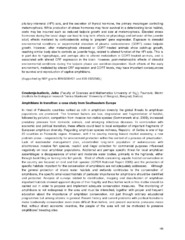Приказ основних података о документу
Amphibians in transition: a case study from Southeastern Europe
| dc.creator | Crnobrnja-Isailović, Jelka | |
| dc.creator | Paunović, Momir | |
| dc.date.accessioned | 2019-07-17T11:14:36Z | |
| dc.date.available | 2019-07-17T11:14:36Z | |
| dc.date.issued | 2012 | |
| dc.identifier.uri | https://radar.ibiss.bg.ac.rs/handle/123456789/3428 | |
| dc.description.abstract | In most of Palearctic countries ranked as rich in amphibian diversity the global threats to amphibian populations are prominent. The foremost factors are loss, degradation and fragmentation of habitat, followed by pollution, competition from invasive non-native species (Sommerwerk et al. 2009), increased predatory pressure from domestic animals, and emerging infectious diseases. In combination with economic and political transition, these effects could lead to local extirpation of important fragments of European amphibian diversity. Regarding amphibian species richness, Republic of Serbia is one of top 20 countries in Palearctic region. However, with t he country moving toward market economy, a new problem arose – responsibility for environment protection within the context of a process of privatization. Lack of wastewater management plan, uncontrolled long-term population of watercourses with allochtonous invasive fish species, roadkill and illegal collection for commercial purposes influenced negatively on local amphibian populations. Additional and perhaps specific threat for local amphibian assemblages is disappearance of small and moderate water bodies, primarily in the highlands, either through backfilling or turning into fish ponds. Most of efforts concerning aquatic habitat conservation in the country are focused on bird and fish species (ICPDR National Report 2005) and the protection of specific habitats important for the conservation of amphibians are not adequately addressed. Although the general protection of inland water habitats and wetlands contributes to the conservation of amphibians, the specific small-sized habitats of particular importance for amphibians should be identified and protected. Analysis of surveys related to identification, mapping and classification of amphibian important habitats showed apparent degree of their fragility and thus further work in this matter should be carried out in order to propose and implement adequate conservation measures. The monitoring of amphibians is not widespread in the area and must be intensified, together with proper and frequent education about the importance of amphibian conservation, not just through ordinary educational programmes but among citizens in general. Recent history and current problems with political transitions make biodiversity conservation even more difficult than before, and present economic pressures mean that, without direct economic incentive, the people of the area will not be motivated to preserve amphibians‘ breeding sites. | en |
| dc.language.iso | en | sr |
| dc.publisher | World Congress of Herpatology | sr |
| dc.rights | openAccess | sr |
| dc.source | 7th World Congress of Herpetology; Vancouver, Canada; 2012 Aug 8-14 | sr |
| dc.title | Amphibians in transition: a case study from Southeastern Europe | en |
| dc.type | conferenceObject | sr |
| dc.rights.license | ARR | sr |
| dcterms.abstract | Пауновић, Момир; Црнобрња Исаиловић, Јелка; | |
| dc.rights.holder | World Congress of Herpatology | sr |
| dc.citation.spage | 155 | |
| dc.type.version | publishedVersion | sr |
| dc.identifier.fulltext | https://radar.ibiss.bg.ac.rs/bitstream/id/5275/bitstream_5275.pdf | |
| dc.identifier.rcub | https://hdl.handle.net/21.15107/rcub_ibiss_3428 |

